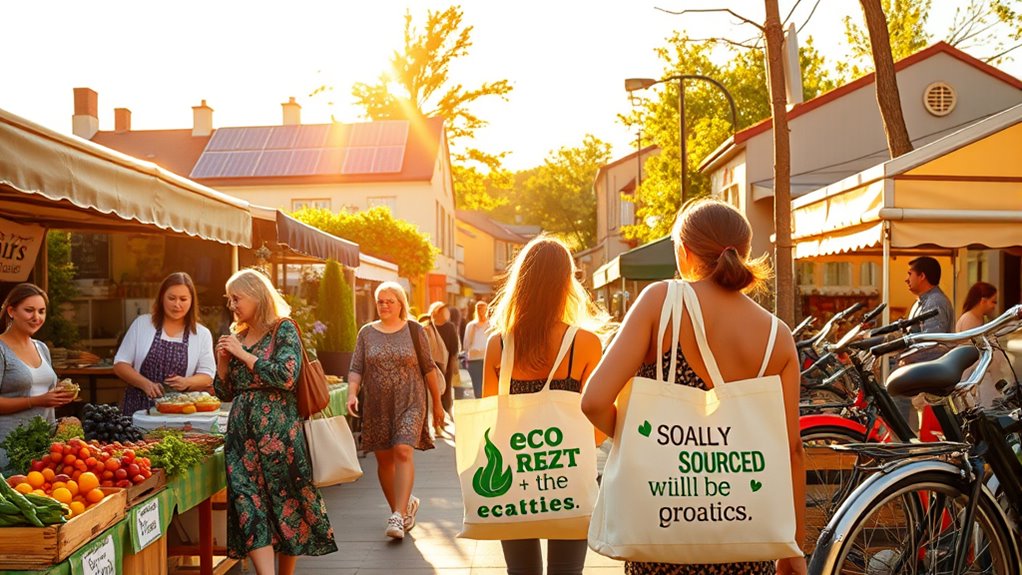Climate change is shaping your behavior by making you more conscious of sustainability and the environment. You might shop less for fashion and gadgets, seek eco-friendly brands, or choose secondhand options to reduce waste. You may also adjust your diet, invest in energy-efficient home upgrades, or prefer local foods to cut logistical risks. Younger generations especially demand transparency and meaningful action from brands. To discover how these shifts impact your daily choices, keep exploring these evolving trends.
Key Takeaways
- Consumers are increasingly prioritizing sustainable products, secondhand markets, and brands with transparent environmental practices.
- Climate concerns drive lifestyle changes such as dietary shifts, home upgrades, and relocation considerations.
- Younger generations, especially Gen Z, demand eco-friendly options and scrutinize greenwashing efforts.
- Economic constraints lead many to reduce eco-friendly purchases, emphasizing cost savings alongside sustainability.
- Urban and rural areas adopt targeted adaptations like public transit use and climate-resilient infrastructure to cope with climate impacts.

Climate change is no longer a distant threat; it’s a present reality that’s directly influencing your daily choices. As climate change accelerates, consumers are increasingly adjusting their behaviors to address environmental concerns. Recent surveys reveal that over two-thirds of Americans are genuinely worried about climate change, and worldwide, 69% of adults have altered their habits to reduce their ecological footprint.
Climate change now shapes daily choices, with over two-thirds of Americans worried and habits shifting globally.
Younger generations, especially Gen Z, are leading this shift—about 75% of them have changed their consumption patterns because of climate worries. Many are also considering relocating to milder climates, with nearly half of Gen Z and millennials contemplating such moves to escape climate-related risks. Climate resilience is becoming a key factor in housing and community planning, reflecting how deeply climate concerns influence lifestyle decisions.
This heightened awareness has resulted in noticeable changes in purchasing habits. You might notice that many are cutting back on fashion accessories and gadgets—around 61% and 51%, respectively, are spending less on these items. Clothing and footwear purchases are also decreasing, as consumers prefer more sustainable options. Additionally, the rise of secondhand and resale markets reflects this trend, driven by a desire for durable, repairable products that last longer and generate less waste.
Instead of fast fashion, consumers now prioritize quality and sustainability, favoring brands that offer repair, refill, and recycling services. However, economic constraints play a significant role in these behavioral shifts. During downturns, many find it hard to afford eco-friendly products.
About 73% cite cost savings as a key reason for reducing purchases, while nearly half see new items as unnecessary. Limited access to affordable sustainable options further hampers widespread adoption, especially among lower-income groups, for whom price sensitivity often outweighs environmental concerns.
Climate impacts also influence your food and home choices. Many are considering dietary changes due to food price hikes and availability issues—42% are thinking about it, and 29% have already altered their diets. Some are investing in protective products like air purifiers or climate-resilient home upgrades, such as better insulation and energy-efficient systems. Implementing climate-resilient infrastructure can significantly mitigate potential damages caused by extreme weather events. This growing focus on resilience is driven by a better understanding of climate science and its implications for daily living.
There’s a growing demand for locally sourced foods and supply chains that reduce climate-related logistical risks. Additionally, advances in renewable hydrogen production through methods like electrolysis using renewable energy sources could further reduce the carbon footprint of these lifestyle modifications supporting sustainable energy. Generational divides are clear: Gen Z is most proactive, with nearly half contemplating relocating and prioritizing transparency from brands about sustainability.
Younger consumers favor digital platforms for swapping or renting goods instead of owning, and they support certifications indicating carbon neutrality. In contrast, older demographics tend to stick with their traditional consumption habits, constrained by entrenched routines.
Ultimately, consumers now expect brands to be transparent and committed to real environmental progress. Trust diminishes when companies greenwash or fail to show measurable sustainability efforts.
Urban dwellers are embracing public transit and biking more, while rural communities focus on self-sufficiency. Coastal regions invest in flood-resistant homes, reflecting how climate change continues shaping consumer behavior across all sectors. Recognizing the importance of sustainable development, many industries are adapting their practices to meet these evolving consumer expectations.
Frequently Asked Questions
How Do Cultural Differences Influence Climate-Conscious Consumer Choices?
Cultural differences shape your climate-conscious choices by influencing what you value and how you act. If you’re in Spain, you may focus on quality of life, making you seek premium sustainable products.
In Colombia, your choices might connect to biodiversity and tradition, guiding you toward locally rooted practices. Your cultural background impacts your perceptions of affordability, responsibility, and community, ultimately shaping how you engage with eco-friendly habits and products.
What Role Does Social Media Play in Shaping Eco-Friendly Purchasing Habits?
Some might think social media’s influence is superficial, but it actually shapes your eco-friendly choices profoundly. You rely on social media for product research, guided by sustainability-focused accounts, reels, and stories that make complex issues understandable.
Influencers showcase sustainable lifestyles and practical tips, building trust and inspiring action. Interactive tools and social proof motivate you to make greener purchases, while campaigns create urgency—helping you turn eco intentions into real habits.
Are There Specific Demographics More Likely to Adopt Sustainable Behaviors?
You’re more likely to adopt sustainable behaviors if you belong to younger demographics like Gen Z or Millennials. These groups tend to be highly aware of climate issues, active in activism, and influenced by social media content.
Their concern about the environment and trust in political actions motivate them to make eco-friendly choices. Understanding these tendencies can help you see why younger generations often lead the way in sustainable living.
How Does Climate Change Impact Luxury Versus Budget Consumer Segments?
Imagine walking through a bustling market, where luxury buyers handpick leather bags and cashmere sweaters, valuing sustainability for quality and longevity.
Meanwhile, budget shoppers seek durability to stretch their dollars, wary of eco-price hikes.
Climate change pushes luxury consumers to demand transparency and innovation, elevating their brand loyalty.
In contrast, budget segments adapt quickly with synthetic options, focusing on affordability and incremental eco-friendly changes, shaping their purchasing priorities accordingly.
What Psychological Factors Motivate Consumers to Prioritize Environmental Concerns?
You’re motivated by your attitudes and beliefs about the environment, which influence your choices. If you see yourself as knowledgeable and value sustainability, you’re more likely to buy green products.
Your emotional connection to conservation and feeling responsible for environmental issues also drive you to act responsibly.
Social norms and positive feedback reinforce your behavior, making you feel your actions genuinely make a difference in protecting the planet.
Conclusion
As you become more aware of climate change, your choices can make a difference. Did you know that 66% of consumers now prefer eco-friendly products? By opting for sustainable options, you’re helping reduce environmental impact and encouraging companies to prioritize greener practices. Your actions matter more than ever—small shifts in your habits can lead to big change. So, stay conscious, make informed decisions, and be part of the movement shaping a healthier planet for everyone.









